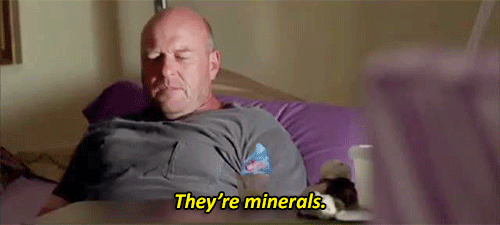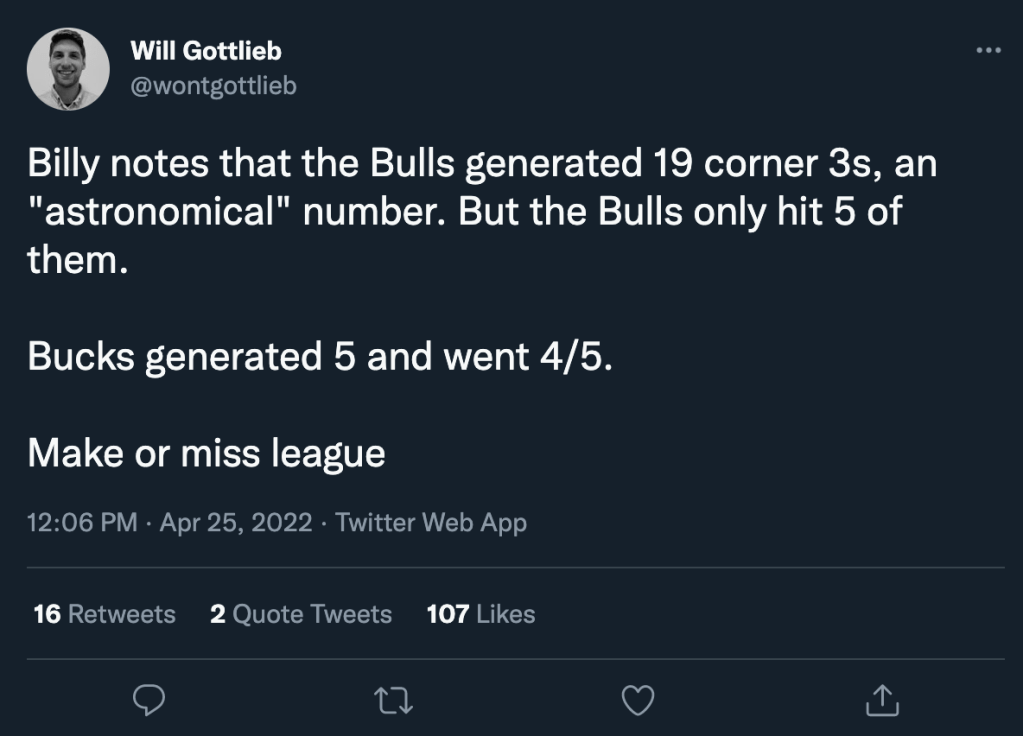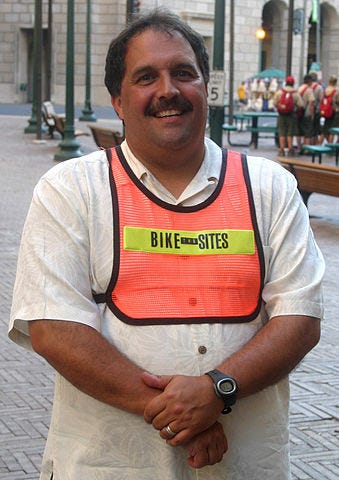
This is going to be a post that offers some criticism of the Bulls front office duo of President of Basketball Operations, Artūras Karnišovas and General Manager, Marc Eversley. Before we get to that, though, it must be said that the Bulls’ new basketball people did a very strong job in their first active offseason following their first year on the job, where they were in “evaluation mode.” Adding DeMar DeRozan, Lonzo Ball, and Alex Caruso in a single offseason, while hitting on the steal of the second round in the draft (well, save for “Not On” Herb Jones) in Ayo Dosunmu is a very successful offseason by any measure. Chicago leapt from a team that won at a 35 win pace, prorated to an 82 game season, to a team that won 46 games. Adding 11 wins to a team’s record and making the playoffs is a substantial accomplishment and the Bulls organization deserves kudos for trying to simply be better and give their city and fans worldwide a team worth their time. They largely succeeded. Speaking as a Bulls partisan, it was the most fun season in half a decade, at least.
Having said all of that, there were some areas where the new front office group came up short. Those areas were largely exposed by COVID absences, injuries, and the pressure cooker of a first round playoff series against the defending NBA Champion, Milwaukee Bucks.
These issues were not really in the big picture shifts, but instead in the marginal moves that defined how the team was built out around the stars and other core pieces. Why does this matter so much? I’ll let Ben Taylor of Thinking Basketball and Backpicks.com take it from here:
The data reflects common sense. As teams grow better, the players surrounding the star grow better. Improvements to the star himself are correlated with more team success, but the supporting players on a team are more important to the team’s success than the star player. This is expected; basketball is not a one-on-one sport. Still, it’s nice to be able to quantify this with a decade of non-box score data.
https://backpicks.com/2017/07/06/supporting-casts-are-more-important-than-stars/
In other words, the true differentiator between bad teams and good teams and good teams and great teams is the supporting cast around the stars, despite what the hot take merchants and great men of history pushers would have you believe. Okay, so what does all that have to do with the Chicago Bulls?
“Too Small, Too Weak, Too Poor”
In a cruel inversion of Stacey King’s famous call, often made on Derrick Rose’s behalf, “too big, too strong, too good,” Chicago’s role players outside their top 6 players (DeMar DeRozan, Zach LaVine, Nik Vučević, Lonzo Ball, Alex Caruso, and Pat Williams) were simply “too small, too weak, too poor.” They didn’t have an adequate combination of size, strength, and skill to hold up over an 82 game season, nor could they go toe-to-toe with Milwaukee’s role players in the postseason.
This team spent large swaths of the season with 6’4″ Javonte Green in the starting lineup guarding front court players more often than not. Green is a spectacularly fun and energetic player and has a place in a rotation, especially over the grinding slog of 82 tilts in a 6 month window that is the league’s regular season. He should be nobody’s starter, however, and the lack of reasonable big wing, four man options available to Billy Donovan after Patrick Williams’s unfortunate freak wrist dislocation was an enormous problem for the Bulls. While he provides hustle and muscle, Green is physically outgunned in most matchups and doesn’t command the respect of a single NBA defense as an offensive threat, beyond as a transition terror and put-back dunk dynamo. This is because, like most of the Bulls non-core players, Green was simply not a shooter or dribbler worth fretting over.
Two players with similar warts to Javonte and less to recommend them, given their lack of his physicality and energy are Derrick Jones Jr. and Troy Brown Jr. Neither player can shoot in a way that frightens foes and they aren’t significant threats with the ball in their hands, despite Brown Jr.’s profile as a theoretical do-a-bit-of-everything-well wing. The reality of TBJ is more a what-does-he-really-do-well-actually? wing. Having three role guys who all are kind of the same guy in their weaknesses without many bit players on the roster who have those weaknesses as strengths is a recipe for problems. This is doubly true for Chicago, given that fully 4 of the Bulls’ top 5 players are guard-sized, with only the much (unfairly) maligned Nikola Vučević providing any true combination of height and heft. As a result, Vučević was overtasked often this season on the glass, while Ball and Caruso were ground down by too often guarding the league’s thickest and strongest wings and big forwards. There’s no data here to prove the point, but it’s hard not to believe that Chicago’s multiple injuries to their defensive cornerstones Ball and Caruso, as well as the aforementioned DJJ and Javonte Green, were the result of the pounding inflicted by perpetually playing up.
Finally, at some point in the season, Billy Donovan decided that Tony Bradley Jr. simply couldn’t really play for him and opted to give minutes to the guy who used to be Tristan Thompson instead. Presumably this had something to do with Tony’s metacarpals being made of minerals.
The problem, of course, is that Tristan Thompson has been somewhere between worthless and actively harmful on a basketball court and in a locker room for multiple years running. This, of course, continued in Chicago. Thompson has been terrible and Chicago’s good vibes, propensity to fight for each other, and problem-solve professionally and collaboratively, all took a notable dip when he arrived. Still, Donovan’s lack of trust in Bradley Jr. makes some sense, as the old ball coach wants his big men to be able to make reads in the short roll and, well, that’s impossible to do if you can’t catch the ball in traffic. (We’ll ignore, here, that while Tristan can catch the ball, he will only ever make the wrong decision with it.)
How Did Chicago Get Here?
Some of these failings were the result of terrible COVID-19 luck and Mitchell Robinson’s being a bit of a reckless doofus, but bad luck and reckless doofuses are things for which you have to have prepare when roster building in this league. Patrick Williams being the only true big-wing, power forward sized player on the roster is simply bad planning.
There were opportunities to do better. Coby White should have been traded in the offseason for someone, anyone with at least two of size, strength, and skill. Coby is skilled, but undersized and very weak. He’s also massively redundant on a team that includes Zach LaVine, Lonzo Ball, Alex Caruso, DeMar DeRozan, and even, Ayo Dosunmu. While we’re at it, White’s skill-level, strong as it is, often doesn’t translate to actual success, as his processing speed and decisionmaking generally leave much to be desired, on both ends of the court. Ideally a Coby swap would have brought someone with wing size and a reasonably good jumper on the catch. I can forgive the lack of a Coby trade, somewhat, due to his offseason shoulder injury that likely tanked his value during that window. He could have been moved for help at the trade deadline, though, and I think he ought to have been.
Derrick Jones Jr. could have and probably should have been Larry Nance Jr., instead. In the sign-and-trade deal that sent Lauri Markkanen to Cleveland, Nance Jr. was the asset that the Cavaliers sent out in order to get the Big Finn in their building. The Bulls’ braintrust opted for DJJ and a protected possibly-maybe-but-good-chance-it’s-not first round pick from the Blazers, over cutting Portland out of the deal and simply taking Nance for themselves. Nance is simply much better than DJJ, to my eyes, and more than that he would have provided the Bulls with additional size both in height and bulk. After being dealt a second time by the Blazers for very little to New Orleans, Nance has demonstrated his value under the bright lights of the playoffs getting significant minutes against the regular season’s best team, your Phoenix Suns, while Jones Jr. has been relegated to an end-of-bench rotation piece against Milwaukee.
Management also had an opportunity to add additional talent and talent that fit a need on the roster, if they had simply cut Matt Thomas to sign Stanley Johnson for the rest of the season. Some of this was determined by the Bulls’ seeming COVID-19 curse, with Johnson getting the novel coronavirus immediately after being brought on as a pandemic hardship signing and just as quickly being cut. It didn’t have to be that way, though. The Bulls’ head honchos could have just given Johnson a standard minimum contract, rather than the hardship deal he was on, and to reiterate, let go of Matt Thomas, who provided effectively nothing all year and especially did nothing to solve Chicago’s biggest role player issue: lack of big wing size and strength. Johnson is a 6’6″ 240 pound brick house and a tenacious point of attack defender who would have helped immensely in the holiday-season doldrums where the Bulls were down large chunks of their defensive personnel for weeks and weeks. It didn’t have to be Johnson, either. Anyone in Johnson’s mold would have been much more useful for this roster than Thomas, who was too small and weak, and his jumper too inconsistent given the first two.
Signing Tony Bradley Jr. and his notably bad hands when your head coach insists that his centers, including backups, must be able to catch the ball and make passes and reads as a pressure release valve is bad planning. It’s doubly bad planning when Isaiah Hartenstein was on the free agency market, flapping in the breeze well past the point at which Chicago’s decision-makers had already committed to Tony B. Hartenstein had to sign a training camp deal with the Clippers, and his deal wasn’t even fully guaranteed until midway through the season! All of this despite Hartenstein’s well-demonstrated cromulence as a short roll decisionmaker, in-a-pinch scorer, and defender in stops in Houston, Denver, and Cleveland prior to landing in Los Angeles. Signing Hartenstein also likely would’ve given the Bulls’ bosses little reason to consider giving Tristan Thompson a look, let alone a piece of the biannual exception, limiting their options for the summer of 2022.
Nance Jr., Stanley Johnson, and Hartenstein would have been much better moves on the margins than Jones Jr., Matt Thomas, and Tony Bradley Jr. / Tristan Thompson. Of course, maybe all of this is only obvious with the benefit of hindsight, but if the front office had identified the problem of being too small and weak and too unskilled they might have made these or similar moves. An obvious objection here is that none of these three would have solved the Bulls’ “others” lack of shooting prowess, but at the very least, the defense would have held up better in the prolonged absences of Caruso, Ball, and Javonte Green. Hard Rock’s short roll passing also may have been enough offensive WD-40 with bench units to paper over some of the spacing concerns. An in-season trade of Coby White for a similarly priced defensive wing shooter would have helped here, too.
This is all to say nothing of the marginal losses of giving up too many picks in the Vučević and DeRozan swaps, nor the mistake of trading a good, young cost-controlled center in Daniel Gafford for Troy Brown Jr. who is… still kind of young and little else worth mentioning. In fairness to Karnišovas and Eversley, though, Javonte Green on a minimum contract was part of that deal and easily the best part of it for Chicago.
What To Do About All This?
Karnišovas and Eversley must spend this offseason rebuilding the Bulls’ 8-15 spots on the roster. DeRozan, LaVine (more on him and his impending free agency soon), Vučević, Caruso, Ball, Williams, and Dosunmu should all be back. (Javonte can probably stay, too, given all the surplus value he provides over his remaining one year, minimum salary deal.) Everyone else can and likely should be replaced.
Trading Coby this summer must happen, as he is unlikely to be someone the Bulls can or should pay his next deal, given likely cost and roster redundancies. Unfortunately, White has largely been an eyesore these playoffs on both ends, so he’s unlikely to return more than marginal talent, especially on his expiring deal, even with the restricted free agent rights that come with said deal. Get anything of value you can and move on.
Drafting for need is a mug’s game, but if the best player available calculus says there’s a tie, go for the player with the big wing size, strength, and shooting, please. I’m not NOT talking about Tari Eason and/or EJ Liddell, here.
Besides trading Coby and their first round pick, the Bulls’ other tools for improvement are some form of the midlevel exception (tax-payer or otherwise), the Daniel Theis $5 million traded player exception (TPE), and veterans’ minimum deals. If they can convince the Thunder to fork over Mike Muscala (a shot-blocking, three point shooter with a bargain price-tag) for the Theis exception, that’d be a nice bit of business, however unlikely it may be. Maybe Thaddeus Young is interested in returning to Chicago on the cheap. Maybe one of Kyle Anderson or either Martin twin can be had for the midlevel exception. What will Taurean Prince fetch? None of these are perfect fits, but they’re clearly better options than those Donovan had this season and someone should be gettable.
Even a player like Ben McLemore on a minimum contract would provide much more of a spacing threat, if nothing else, around the Bulls core than the current players so that a team like the Bucks couldn’t surrender 19 corner three pointers in a single playoff game with little worry that it would burn them.
I, a random blogger on the internet, obviously, don’t have all of the answers for how to fix the Bulls’ 8-15 spots this offseason. That’s ultimately not the point, nor am I qualified or interested in gaming out every possible option. I would like to present some general principles for the Bulls’ roster building around the core 6 guys, though.
Get players who:
- defend well enough across multiple positions that they aren’t playoff targets
- must be respected as shooters and quick decision-makers
Sounds very simple but given how valuable the “others” are in making a team great and the preference for that combination of skills league-wide, it will be a major challenge, but hey, that’s the job. Whether the Bulls are able to get proven vets in these spots with these talents or are able to make some international ball or G-League finds is irrelevant for our purposes, but bottom line, they must find these kinds of players to improve the roster.
Oh, and find a back up center that can catch and pass the ball!



